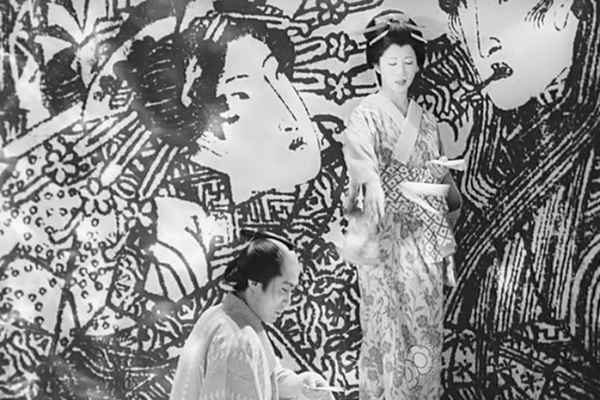First of all, Double Suicide was really wonderful to look at. Every scene was simply gorgeous in black and white. It is a film that almost does not need sound, and in fact, does not employ much of it. The small amount of music that does appear is minimal and eery.
One particularly impressive moment was when the courtesan Koharu is opening a door bit by bit, covered by the sound of a man clapping two pieces of wood together. The scene was so expertly and seamlessly choreographed, the balance between action and sound was so clear!
A still from that moment
One of my favorite elements to this story was the presence of the kurago, the men dressed in black who played the role of stagehands and of fate. Their spooky presence added another layer of separation from the viewer's immersion into the film. In fact, at one moment the face of the male lead, Jihei, is revealed to his wife Osan only with the help of the kurago lifting a blanket away from him.
At one point a kurago even reveals he is really present in the moment and feels for the characters even though he is bound to his duty as the hand of fate. This mirrors the struggle that Koharu and Jihei undergo. Koharu is obligated as a courtesan to please many different men but as a result is not respected by most of society. Jihei has familial obligations and cannot abandon them to chase a "whore". Even though they fight against the current, they are totally predestined to kill each other from the first moments of the opening credits where the director of the play they live out is discussing their double suicide.
In fact, in Jihei's final moments we can see many kurago waiting for him to kill himself, even helping him. It really drives home the presence of fate in this film and the inescapable destiny that the film promotes.
Despite Koharu and Osan's differences there is an interesting duality to their characters. First, they are played by the same actress. Koharu has painted eyebrows while Osans are covered in white makeup, as are her lips while Koharu's aren't. Osan's teeth are noticeably blacked out, which without personally knowing the Japanese tradition behind it, really gave Osan a disturbing connection with decay or death.
Just as the Criterion website describes, "The mutual respect felt by the women is constantly stressed, as if, in fact, they were conflicting aspects of personality"
The imagery in this film ranged from stark divides between black and white to patterns filling up entire rooms. The environment, this includes the kurago and the changing sets, interested me so much in this film. Just brainstorming ideas for a final project, I'm thinking of perhaps writing a series of letters to people in my life who are close to me. The body of the letters would be highly concentrated on vivid moments I have associated with them in my memory. For each one I would take a bit of inspiration from each film from the semester. I'm also interested in perhaps including images but it might be filled with text. When I have them all finished I would compile them in a small photo album, so I guess the general theme is snapshots. It's an idea in progress...
-Claudia


No comments:
Post a Comment